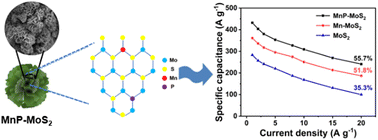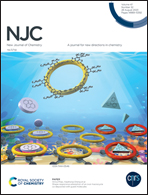Flower-like manganese and phosphorus co-doped MoS2 with high 1T phase content as a supercapacitor electrode material†
Abstract
Molybdenum disulfide (MoS2) usually exhibits a severe stacking and agglomeration phenomenon, and an inferior rate capability and cyclability as a supercapacitor electrode material. Heteroatom doping and phase engineering are the available methods to ameliorate the electrochemical performances of MoS2. Herein, flower-like manganese and phosphorus co-doped MoS2 (MnP–MoS2) is successfully fabricated via using manganese chloride and sodium hypophosphite as dopants. The obtained MnP–MoS2 possesses a large interlayer spacing of 0.88 nm and a high 1T phase content of 82.9%. Thanks to the synergistic doping effect of Mn and P, MnP–MoS2 delivers a maximum capacity of 432.3 F g−1 at 1 A g−1 and maintains 55.7% of the initial capacity at 20 A g−1. Moreover, the asymmetric supercapacitor (ASC) device fabricated using MnP–MoS2 as the positive electrode and activated carbon (AC) as the negative electrode displays an energy density of 16.7 W h kg−1 at 403.9 W kg−1, and keeps 84.4% of the original capacity after 2000 cycles. This work proposes a versatile strategy to develop other two-dimensional transition metal chalcogenides as high-performance electrode materials for supercapacitors.



 Please wait while we load your content...
Please wait while we load your content...